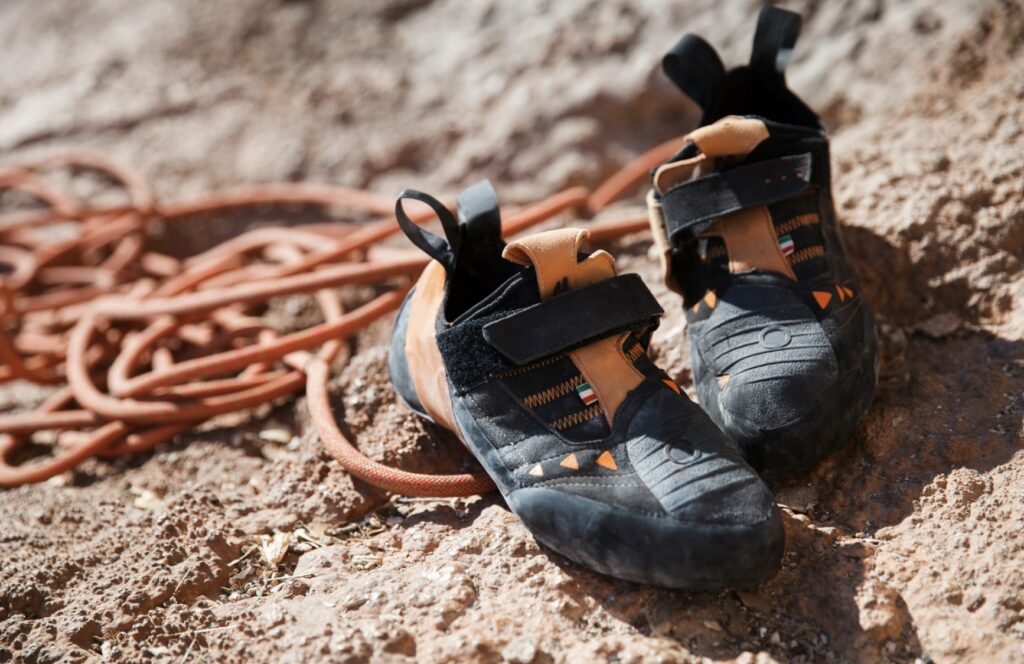How to Choose Rock Climbing Shoes Right Way

How to Choose Climbing Shoes can feel like a daunting task, especially for beginners.
It’s not just about picking the coolest looking pair or going with what your friend recommended.
No, folks. Choosing climbing shoes is much more intricate than it appears.
In fact, when it comes to how to choose climbing shoes, there are several factors you need to consider – from shoe type and material used in construction, right down to closure style and last design!
Table of Contents
Understanding Different Climbing Shoe Features
As an experienced climber, you know that the correct climbing shoes can be essential for success.
But how do we choose climbing shoes?
Lace-up Closure for Versatility
The first feature to consider is closure style.
Lace-up closures allow climbers to adjust shoe fit during different stages of their climb.
Strap Closure for Convenience
Moving on, let’s discuss strap closures.
These are particularly beneficial when taking breaks between bouldering or gym sessions as they provide easy on/off convenience.
Slip-on Shoes for Sensitivity
Finally, slip-on shoes are known for their sensitivity.
These characteristics allow them to slot into thin cracks easily, making it easier for climbers to make precise foot placements.
In this ever-evolving world of aggressive modern climbing shoes where even custom moulded options exist, it becomes essential not just knowing what type suits your needs but also understanding a store’s climbing shoe return policy before making a final decision to choose shoes.
As our journey through various features continues, remember everyone’s feet bend slightly differently. Thus, comfort should always be prioritized over any other aspect while choosing footwear, especially if planning long routes like big wall style ones which require extended periods wearing these gears without discomfort. Moderate shoes combine performance and comfort, providing the perfect balance.
In the next section, we will delve deeper into materials used in constructing rock climbing shoe uppers, exploring the differences between leather lined/unlined versions versus synthetic ones along with the pros/cons related to each option. Stay tuned.
Choosing Between Leather and Synthetic Materials
When it comes to climbing shoes, the material used plays a significant role.
The choice between leather or synthetic materials can greatly impact your climbing experience, particularly in terms of stretchability, durability, and breathability.
Unlined Leather Shoes for Stretchability
For those seeking a pair of shoes that will shape to the contours of their feet over time, unlined leather could be an ideal choice.
Lined Leather Shoes for Reduced Stretching
Synthetic Material Shoes: The Non-Stretch Option
Synthetic materials are another popular option when choosing climbing shoes.
While they may not provide as much stretch as their counterparts made from natural fibers like hemp or cotton, synthetics do have some advantages.
For instance, synthetics tend not only durable but also maintain original fitting mostly unchanged after use making them great choices if consistency is key during climbs.
Remember though – every climber’s needs vary so always consider factors such fit comfort level terrain type etc., before making final decision choose shoes.
Decoding Climbing Shoe Lasts
The “last” of a climbing shoe is the foot-shaped model around which it’s built.
This crucial component determines factors such as instep height, volume, and heel-toe dimensions among others.
Slip-Lasted vs Board-Lasted Climbing Shoes
In terms of construction, two types dominate: slip-lasted and board-lasted shoes.
This method results in more flexible footwear that allows climbers to make precise foot placements.
On the other hand, but may compromise on sensitivity.
Straight Last Shape
A straight (or neutral) last shape closely mimics natural foot posture making these ideal for beginners or those prioritizing comfort during long multi-pitch ascents.
The neutral shoe’s flat profile makes them less suitable for technical climbs requiring small footholds.
Asymmetric Last Shape
These are great choices if you’re tackling mildly overhung sport routes where precision matters most.
Downturned Last Shape:
For aggressive modern climbing styles demanding high levels of toe strength – think bouldering problems with steep angles – nothing beats downturned lasts.
They enable climbers to hook onto holds using their feet effectively turning them into another pair of hands.
But remember they might not be as comfortable due to this heavily developed heel area.
Importance of Outsole Rubber Type & Thickness
The type and thickness of the outsole rubber on your climbing shoes can significantly impact your performance.
Outsole Rubber Types
Different rubber types used in climbing shoes cater to various needs depending upon the terrain you are tackling.
Firmer rubbers, for instance, provide excellent support when edging – a technique where climbers place their foot onto small ledges or crevices to ascend vertically.
In contrast, softer shoe soles made from stickier rubber variants offer better smearing capabilities which is essential while ascending slabs without distinct footholds.
Outsole Thickness Considerations
Aside from the rubber material, its thickness is also an essential factor in climbing performance.
- A thicker sole (4-5mm) provides more durability and support making it a great choice for beginner climbers who may not have developed precise footwork yet.
- A thinner sole (around 3mm), although less durable than its counterpart, offers increased sensitivity allowing experienced sport climbers to feel subtle features beneath their feet enhancing precision during challenging climbs.
It is stated that choosing between these options depends largely on personal preference as well as specific requirements based on planned routes.
Remember that regardless of whether you opt for stiffer shoes with firmer rubbers or go with soft shoes having sticky soles; comfort should be paramount since discomfort could lead to poor focus affecting overall safety and enjoyment.
In addition, keep track about wear patterns over time. If certain areas like toe sections seem worn-out faster compared to others, consider discussing this observation at a local gear shop/gym; they might suggest a different model/brand suiting your unique style better, thereby extending the lifespan of expensive shoes.
Lastly, remember there’s no ‘one-size-fits-all’ solution here – take time to try multiple pairs across brands/styles before settling down on one pair, ensuring maximum compatibility with individual preferences and skill level.
Key Takeaway
The type and thickness of the outsole rubber on climbing shoes can greatly impact performance. Different rubber types cater to various needs, with firmer rubbers providing support for edging and softer stickier rubbers offering better smearing capabilities. The thickness of the sole also plays a role, with thicker soles providing durability and support for beginners, while thinner soles offer increased sensitivity for experienced climbers. Comfort is key, as discomfort can affect focus and safety. Consider wear patterns over time and try multiple pairs before settling on one.
Exploring Women’s (Low-volume) & Kids’ Climbing Shoes Options

If you have low volume feet, women-specific climbing shoe designs may offer a better fit.
This is not about stopping men from wearing women’s shoes but rather understanding that everyone’s feet bend slightly differently and manufacturers cater to these variations in their design process.
Why Consider Low-Volume Climbing Shoe Designs?
The aggressive modern climbing shoes exist for every climber regardless of gender.
Your final decision should always be based on comfort, performance needs, and how well they mold around your unique foot shape – which might mean opting for custom moulded climbing shoes if necessary.
This article provides some great insights into this topic worth checking out before making any purchase decisions.
Kids’ Rock Climbing Footwear: What Makes It Unique?
Moving onto younger climbers now – kids’ rock climbing footwear options are designed with growing feet in mind while still providing all essential features required to make tiny foot placements stick during climbs.
- The sole thickness tends to be thinner allowing young climbers to feel the rock beneath them aiding in developing critical sensory skills early on.
- A mildly overhung sport routes friendly profile helps maintain comfort without compromising too much on precision.
- An additional rubber layer covers toe areas preventing premature wear-outs due to heavy use especially indoors where most beginner level sessions take place.
Remember though; no matter what age group you’re shopping for it’s crucially important that new users get used-to their gear gradually starting off with less demanding terrains/routes initially until full confidence develops. Always remember each store’s return policy when buying online since getting an ideal fitting pair sometimes requires trial/error attempts.
FAQs in Relation to How to Choose Climbing Shoes
How to choose your first climbing shoes?
For beginners, comfort should be the priority. Choose a shoe with flat last and a thicker rubber sole for durability. Opt for an adjustable closure system like laces or straps.
Should I size up or down in rock climbing shoes?
Climbing shoes should fit snugly but not painfully tight. It’s common to size down from street shoe sizes, but avoid excessive discomfort as it can hinder performance.
How do you know if climbing shoes are a good fit?
A well-fitting climbing shoe feels snug all around without any air pockets or painful pressure points. Your toes should lay flat in neutral models and slightly curled in aggressive ones.
Do different climbing shoes make a difference?
Absolutely. Different styles of climbs require specific types of footwear – slab routes benefit from softer soles while overhangs need downturned lasts for better hooking capabilities.
Conclusion
Decoding the world of climbing shoes isn’t as daunting as it seems.
You’ve now got a handle on how different shoe features cater to varying needs and preferences.
The importance of material choice, whether leather or synthetic, is no longer a mystery.
You’re aware that the ‘last’ shapes your climbing experience – literally!
And you know that outsole rubber type and thickness are key players in grip and sensitivity.
Women’s low-volume designs? Kids’ footwear options? You’ve got those covered too!
Congratulations! You’re progressing towards settling on a wise pick regarding the selection of climbing shoes. Your next adventure awaits…


Deeba & Matt
About the Authors
Intrepid content creators and relentless hiking enthusiasts. With a passion for travel and adventure, Matt & Deeba are never one to shy away from a daring challenge.
